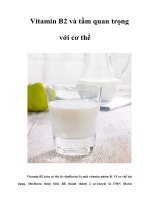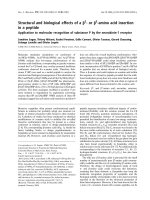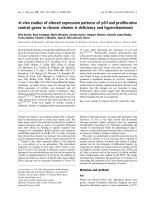VITAMIN B3 and VITAMIN B2
Bạn đang xem bản rút gọn của tài liệu. Xem và tải ngay bản đầy đủ của tài liệu tại đây (3.13 MB, 20 trang )
V
I
T
A
M
I
N
B
3
a
n
d
V
I
T
A
M
I
N
B
2
Ha Thi Thuy Hoa
K15 Honor Program
of Biology
C
l
i
c
k
i
c
o
n
t
o
a
d
d
p
i
c
t
u
r
e
OUTLINE
I. Introduction
II. Vitamin B3: Nicotinic acid and Vitamin B3-
the nicotinamide coenzymes : NAD+ and
NADP+
III. Vitamin B2: Riboflavin and the Flavin
Coenzymes FAD, FMN
IV. Summary and Question
I. INTRODUCTION
What is the most important function of Vitamin B ?
Why do we need vitamin B everyday?
Play important roles
in cell metabolism.
= They are
coenzymes for
carrying hydrogens and
their electrons during
metabolic reactions
II.Nictotinic acid
Nicotinamide adenine dinucleotide (phosphate)
NAD NADP
Reaction of NAD
and NADP/NADPH
In many cells and tissues, the ratio NAD/NADH is high,
therefore favoring hydride transfer from a substrate to NAD to
form NADH.
->Role: NAD generally functions in oxidations – a part of
catabolic reaction.(oxidation such as pyruvate in the
mitochondrial matrix)
By contrast, NADPH is generally at a higher concetration than
NADP, favoring hydride transfer from NADPH to substrate.
->Role: NADPH is the usual coenzyme in reduction – as part of
an anabolic reaction (synthesis fatty acid in the cytosol)
Deficiency : Pellagra disease
III.Riboflavin
Flavin adenine dinucleotide (FAD)
Flavin
mononucleotide (FMN)
Flavoprotein
Flavoprotein are enzymes that catalyze oxidation-
reduction reactions using either FMN or FAD as
coenzymes.
FMN and FAD bind tightly to proteins such as
succinate dehydrogenase(in Krebs cycle). They do
not transfer electrons by diffusing from one enzymes
to another.
Under the reversible reduction, accepting either one
or two electrons in the form of one or two hydrogen
atoms from a reduced substrate.
The fully reduced form : FADH2 and FMNH2
Reaction of Riboflavin
Function of flavoproteins
Electrons carriers in oxidative phosphorylation (in
mitochondria)
Serve as light receptors in cryptochromes in chloroplast in
plant.
DIET OF VITAMIN B3
DIET OF VITAMIN B2
IV. QUESTIONS AND CONCLUSION
1. How many electrons NAD and FAD can carry?
Answer: NADH can transfer 2 electrons and 1 proton
while FAD can accept or donate electrons 1 or 2 at a time
and also 1 or 2 protons.
2. What is flavoprotein?
Answer: Flavoprotein are enzymes that catalyze
oxidation-reduction reactions using either FMN or FAD
as coenzymes. FMN and FAD bind tightly to proteins.
references
Text books: 1. Hoa Sinh hoc, Pham Thi Tran Chau, Tran
Thi Ang. 2. Principle of Biochemistry, Lehninger.
/>
/>achaney/tmve/wiki100k/docs/NADH_dehydrogenase.ht
ml
/>
http://
en.wikipedia.org/wiki/Nicotinamide_adenine_dinucleoti
de
/>e
THANKS FOR YOUR ATTENTION
Figure 7.4
Coenzyme Action
©2003 Wadsworth, a division of Thomson Learning, Inc. Thomson Learning™ is a trademark used herein under license.









